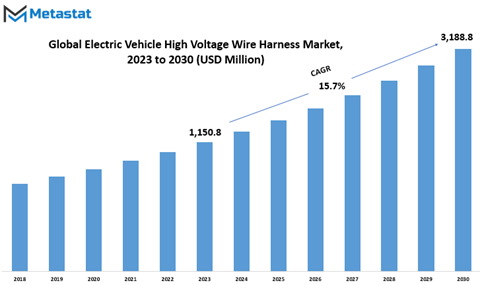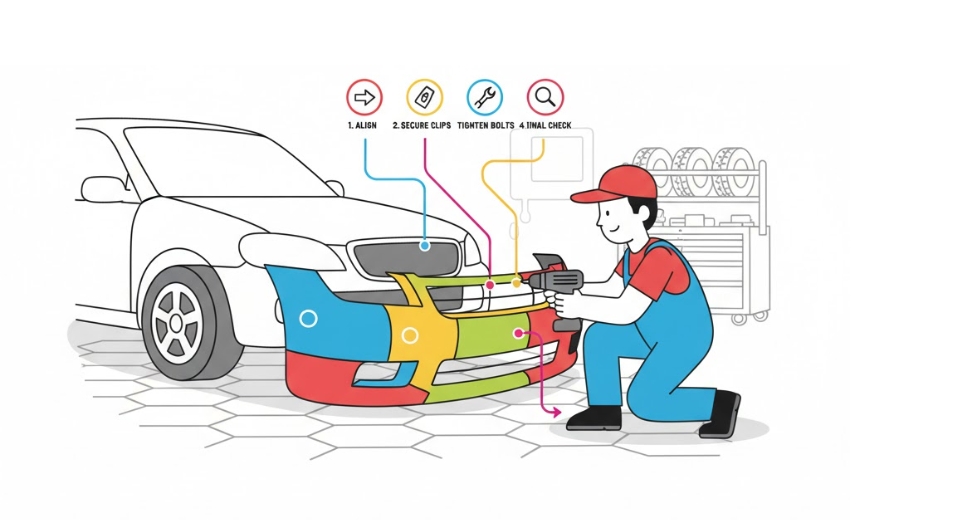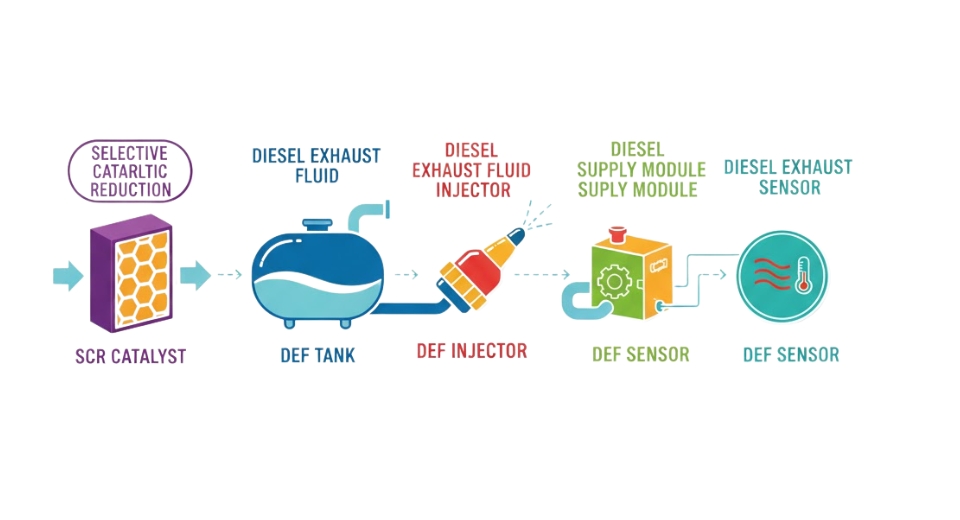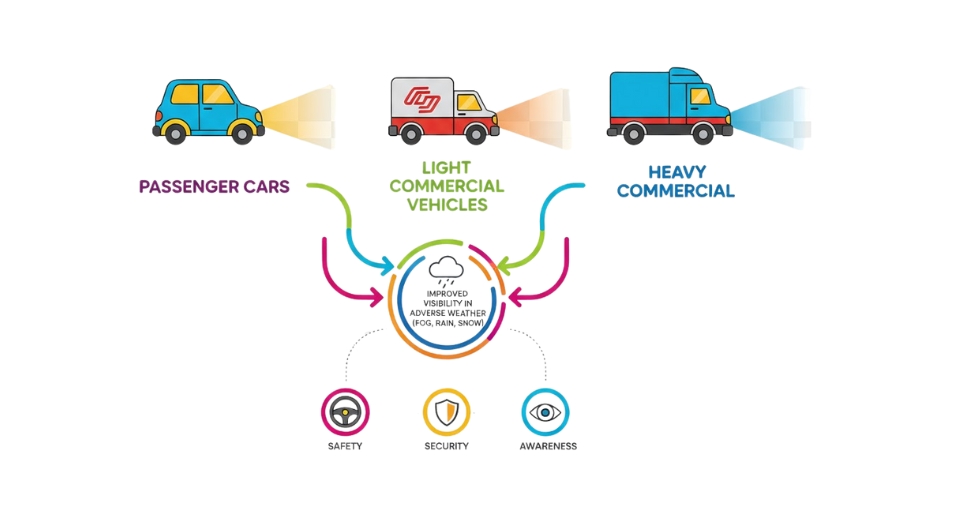MARKET OVERVIEW
The Electric Vehicle High Voltage Wire Harness Market caters to the electrification of transportation on a global scale. As the world steadily shifts towards sustainable and eco-friendly modes of mobility, electric vehicles (EVs) have taken center stage, revolutionizing the way we think about transportation. At the heart of these cutting-edge EVs lies the high voltage wire harness, a crucial component responsible for transmitting electrical power throughout the vehicle.
The electric vehicle industry, driven by the growing demand for cleaner and more energy-efficient transportation options, has witnessed a surge in innovation and development. High voltage wire harnesses, also known as wiring systems, play a pivotal role in ensuring the efficient and safe distribution of electrical power within EVs. They are meticulously designed and engineered to handle high voltage power and deliver it to various electrical components within the vehicle, including the electric motor, battery, and charging system. Moreover, these wire harnesses need to withstand harsh environmental conditions, ensuring the longevity and reliability of an EV's electrical infrastructure.
One of the most distinctive characteristics of the Electric Vehicle High Voltage Wire Harness Market is its constant evolution. As electric vehicle technology advances so must the wiring systems that power them. The demand for more efficient and compact wire harnesses is driving continuous innovation in this sector. Manufacturers are constantly pushing the boundaries of material science and engineering to develop wire harnesses that are not only robust and durable but also lightweight and space-saving. This innovative spirit ensures that electric vehicles become more efficient and cost-effective, thereby promoting their widespread adoption.
The global shift towards reducing carbon emissions and curbing environmental pollution is a key driver for the Electric Vehicle High Voltage Wire Harness Market. Governments around the world are enacting stringent regulations and offering incentives to promote electric vehicle adoption. As a result, automakers are under pressure to produce a broader range of EVs to meet the growing demand. This, in turn, fuels the demand for high voltage wire harnesses. In addition, the increasing number of electric vehicles charging stations and infrastructure development further accentuates the significance of this market.
The Electric Vehicle High Voltage Wire Harness Market is not only influenced by regulatory and environmental factors but also by rapid technological advancements. With the advent of autonomous driving and the integration of advanced driver-assistance systems (ADAS), wire harnesses have to accommodate an ever-increasing number of sensors, cameras, and electronic components. This trend requires harnesses that are not only capable of transmitting high voltage power but also managing complex data and information flows, making the market even more challenging and dynamic.
Global Electric Vehicle High Voltage Wire Harness market is estimated to reach $3,188.8 Million by 2030; growing at a CAGR of 15.7% from 2023 to 2030.

GROWTH FACTORS
The Electric Vehicle High Voltage Wire Harness Market is currently experiencing significant growth, thanks to various factors driving its expansion. One of the key drivers of this market is the initiatives taken by governments worldwide to reduce carbon emissions and promote the use of electric vehicles. The concern for environmental conservation and a desire to curb pollution has led to policies and incentives designed to encourage the adoption of electric vehicles. These initiatives encompass a range of measures, from subsidies and tax incentives to stricter emissions regulations.
Furthermore, the growing demand for fuel-efficient and low-emission vehicles is another crucial factor fueling the market's growth. With a global shift towards sustainability and energy efficiency, electric vehicles have emerged as a viable solution. They produce zero tailpipe emissions and are considerably more energy-efficient than their conventional counterparts. This appeal is particularly strong among environmentally conscious consumers who are concerned about air quality and climate change.
However, it's worth noting that the high initial cost of electric vehicles compared to conventional vehicles poses a challenge to the market's expansion. Electric vehicles are equipped with advanced technologies and costly components, which make them relatively more expensive. While the long-term operational cost is lower due to reduced fuel expenses, the initial purchase price can deter potential buyers.
Another hurdle that the electric vehicle high voltage wire harness market faces is the limited availability of charging infrastructure. This issue is particularly evident in certain regions where the charging network is not as developed as it needs to be. The range and accessibility of charging stations can impact the convenience and practicality of electric vehicles, which can, in turn, affect their market penetration.
Nonetheless, amidst these challenges, there are lucrative opportunities for the market in the coming years. One notable opportunity is the increasing adoption of electric vehicles in developing countries. As these nations aim to modernize their transportation infrastructure and address environmental concerns, electric vehicles are becoming an attractive option. Manufacturers and service providers are expected to expand their presence in these emerging markets, offering a wide array of electric vehicle-related products and services.
MARKET SEGMENTATION
By Type
The market for high voltage wire harnesses in electric vehicles can be categorized into two primary types: shielded and unshielded wiring harnesses. In the year 2022, the shielded wiring harness segment was estimated to have a market value of 659.5 million US dollars, while the unshielded wiring harness segment had a market value of 335.9 million US dollars.
Electric vehicles (EVs) have gained significant attention in recent years due to their potential to reduce greenhouse gas emissions and dependence on fossil fuels. The operation of EVs involves complex electrical systems that require wire harnesses to connect various components and ensure the proper functioning of the vehicle.
One of the key components in the electrical architecture of an EV is the high voltage wire harness. These wire harnesses play a crucial role in transmitting power and signals between different parts of the vehicle, such as the battery, electric motor, and charging system. They are responsible for ensuring the safe and efficient flow of electricity within the vehicle.
The high voltage wire harness market is divided into two main categories based on the type of wiring harness used: shielded and unshielded. These categories differ in terms of design and functionality, and they cater to distinct requirements within the electric vehicle industry.
The shielded wiring harness, with a market value of 659.5 million US dollars in 2022, is designed to provide additional protection against electromagnetic interference (EMI) and radio frequency interference (RFI). These harnesses are equipped with shielding materials, such as metal foils or braids, to safeguard the wires from external interference. Shielded wiring harnesses are commonly used in applications where signal integrity and safety are of utmost importance.
On the other hand, the unshielded wiring harness, valued at 335.9 million US dollars in 2022, does not include the same level of protection against EMI and RFI. These harnesses are often more straightforward in design and are used in applications where the risk of electromagnetic interference is lower, or where cost considerations play a significant role in decision-making.
The choice between shielded and unshielded wiring harnesses depends on the specific requirements of the electric vehicle and the intended application. Shielded harnesses are preferred in situations where electrical signals must remain pristine and uninterrupted, whereas unshielded harnesses offer a cost-effective solution when EMI and RFI are not critical concerns.
By Application
The electric vehicle high voltage wire harness market can be divided into two main applications: passenger cars and commercial vehicles. In 2022, the passenger car segment was valued at 761.6 million USD, while the commercial vehicle segment reached a value of 233.8 million USD.
In recent years, the electric vehicle market has witnessed significant growth and transformation. This shift towards electric mobility is driven by the increasing awareness of environmental concerns and the need for more sustainable transportation options. Electric vehicles (EVs) have gained popularity as a cleaner and more energy-efficient alternative to traditional internal combustion engine vehicles.
One crucial component of electric vehicles is the high voltage wire harness, which plays a vital role in the functioning of these automobiles. These wire harnesses are responsible for transmitting electric power from the vehicle's battery to various components, including the motor, power electronics, and other essential systems. As a result, the electric vehicle high voltage wire harness market has become an integral part of the automotive industry's supply chain.
The market is divided into two primary segments based on application: passenger cars and commercial vehicles. The passenger car segment, which includes electric cars designed for personal use, accounted for a substantial share of the market in 2022, with a value of 761.6 million USD. This segment has experienced robust growth due to the increasing adoption of electric cars by consumers who are looking for eco-friendly and cost-effective alternatives.
On the other hand, the commercial vehicle segment, comprising electric vehicles used for commercial purposes, such as delivery vans and trucks, also had a significant market value of 233.8 million USD in 2022. The growth of this segment is attributed to the increasing focus on reducing emissions in the logistics and transportation industry, where electric commercial vehicles offer an environmentally friendly solution.
The adoption of electric vehicles, whether in the passenger car or commercial vehicle segment, is not only driven by environmental concerns but also by government incentives and regulations promoting cleaner transportation. Many countries have implemented policies to encourage the use of electric vehicles, such as tax incentives, rebates, and stricter emission standards.
Additionally, advancements in battery technology and charging infrastructure have contributed to the growth of the electric vehicle market. Longer driving ranges, faster charging times, and improved battery durability have addressed some of the initial concerns associated with electric vehicles, making them a more attractive option for consumers and businesses alike.

REGIONAL ANALYSIS
The global market for high-voltage wire harnesses in electric vehicles is influenced by various factors, and its performance varies across different geographical regions. In recent years, the electric vehicle industry has experienced significant growth, driven by the increasing demand for eco-friendly transportation solutions. Electric vehicles, often referred to as EVs, rely on a complex network of components to function effectively. One crucial element in these vehicles is the high-voltage wire harness, which serves as the central nervous system, connecting various electrical components throughout the vehicle.
The global market for electric vehicle high-voltage wire harnesses is not uniform but rather segmented by geography, with North America and Europe being significant players in this industry. Let's delve into the specifics of these two regions.
North America, a major player in the electric vehicle market, has seen substantial growth in the adoption of electric vehicles in recent years. The United States and Canada have been at the forefront of this trend. As a result, the demand for high-voltage wire harnesses in the region has been on the rise. With a growing focus on reducing carbon emissions and promoting clean energy, the market for electric vehicles and their components is expected to continue growing.
On the other hand, Europe has also witnessed a surge in electric vehicle adoption. Countries like Germany, France, and the United Kingdom have shown strong commitments to electric mobility. European automakers have made substantial investments in electric vehicle manufacturing, which, in turn, has boosted the market for high-voltage wire harnesses. Additionally, stringent environmental regulations and incentives for electric vehicle adoption have further propelled the growth of this market.
The competition in the electric vehicle high-voltage wire harness market is intense, with numerous players striving to meet the increasing demand. These players include wire harness manufacturers, automotive component suppliers, and electric vehicle manufacturers themselves. Each player in the market is constantly innovating to enhance the efficiency, safety, and durability of wire harnesses, aiming to provide the best solutions for electric vehicle manufacturers.
COMPETITIVE PLAYERS
The Electric Vehicle High Voltage Wire Harness Market is a significant segment within the automotive industry. Key players in this sector include ACOME and Aptiv PLC, among others.
Electric vehicles (EVs) are rapidly gaining popularity due to their eco-friendly nature and the growing concern over environmental issues. EVs rely on an intricate network of components and systems, and one of the essential elements in these vehicles is the high voltage wire harness. These wire harnesses serve as the nervous system of electric vehicles, transmitting power and data to various components, ensuring their proper functioning.
One of the prominent players in the Electric Vehicle High Voltage Wire Harness market is ACOME. ACOME has a strong presence in the industry and plays a pivotal role in the development and production of high-quality wire harnesses for electric vehicles. Their commitment to innovation and cutting-edge technology has positioned them as a leader in this competitive market.
Another key player in this industry is Aptiv PLC. Aptiv PLC, with its extensive experience and expertise in automotive technology, has established itself as a reliable supplier of high voltage wire harnesses for electric vehicles. Their contributions to the sector have been instrumental in the continued growth and advancement of electric vehicle technology.
The electric vehicle high voltage wire harness market is a dynamic and ever-evolving sector, driven by the global shift towards greener transportation options. As the demand for electric vehicles continues to rise, the need for efficient and reliable wire harnesses becomes even more crucial. ACOME and Aptiv PLC, along with other players in the market, are at the forefront of meeting this demand and driving innovation in electric vehicle technology.
Electric Vehicle High Voltage Wire Harness Market Key Segments:
By Type
- Shielded Wiring Harness
- Unshielded Wiring Harness
By Application
- Passenger Car
- Commercial Vehicle
Key Global Electric Vehicle High Voltage Wire Harness Industry Players
- ACOME
- Aptiv PLC
- AVIC Jonhon OptronicTechnology Co., Ltd.
- Champlain Cable Corporation
- COFICAB Group
- Coroflex
- Coroplast Group
- Furukawa Electric Co., Ltd.
- Gebauer & Griller Kabelwerke GmbH
- Tianhai Auto Electronics Group Co., Ltd. (THB Group)
- JYFT
- Kromberg & Schubert Cable & Wire GmbH
- Kunshan Huguang Auto Harness Co., Ltd.
- Lear Corporation
- Leoni AG
- LS Cable & System Ltd.
- Nexans S.A.
- OMG EV Cable
- PKC Group
- Prysmian Group
- Samvardhana Motherson Group
- Shenzhen Deren Electronic Co., Ltd.
- Sumitomo Electric Industries, Ltd.
- TE Connectivity Ltd.
- Yazaki Corporation
- Yura Harness Co., Ltd.
- BizLink Group
- SINBON Electronics Co., Ltd.
WHAT REPORT PROVIDES
- Full in-depth analysis of the parent Industry
- Important changes in market and its dynamics
- Segmentation details of the market
- Former, on-going, and projected market analysis in terms of volume and value
- Assessment of niche industry developments
- Market share analysis
- Key strategies of major players
- Emerging segments and regional growth potential








 US: +1 3023308252
US: +1 3023308252






